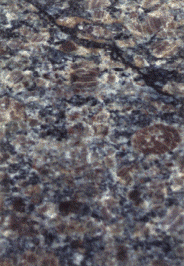Locality:
Saint-Alexis-des-Monts, Quebec, Canada
Geologic Age:
Precambrian (Late Grenvillian, approximately 1.1 billion years ago)
Technical Description:
A crystalline, igneous rock, the Saint-Didace massif is described (Nantel,1983) as predominately quartz monzonite and granite, but floor and counter materials are actually closer to quartz syenite containing approximately 15% quartz, 55% alkali-feldspar, 20% plagioclase feldspar, and 10% hornblende and biotite. The brownish color is imparted by 2-to-5 centimeter tabular to ovoid phenocrysts, sometimes rimmed by white plagioclase (Rapakivi texture). The rock is sharply porphyritic (potassium feldspar megacrysts in fine-grained quartz-plagioclase-hornblende-biotite groundmass), and generally lacks a strong foliation or lineation. Locally high concentrations of mafic minerals (hornblende plus biotite) in clots and irregular patches may represent partially assimilated fragments (xenoliths) of the surrounding country rocks.
General Description:
The stone was quarried about halfway between Montreal and Quebec City from within the 77-square-kilometer (30-square-mile) Saint-Didace massif of the Grenville tectonic province. As a dimension stone, it is marketed as the "Autumn Brown Granite" or "Newton Granite."
